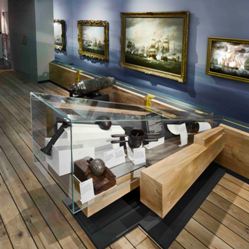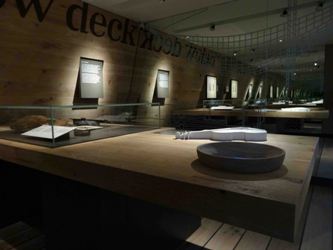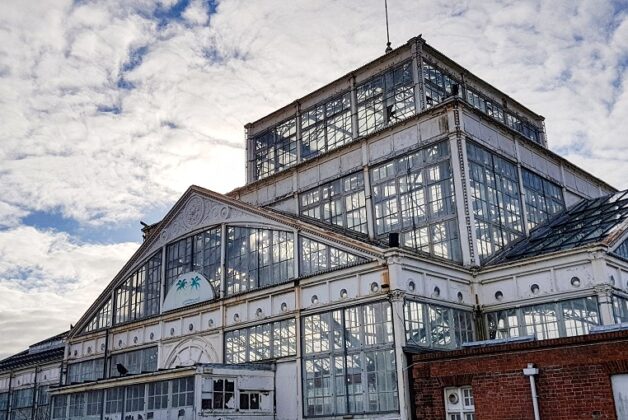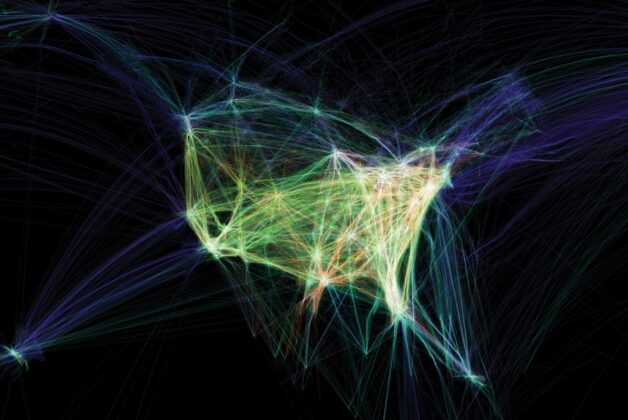Described by the National Maritime Museum as a ‘landmark’ gallery, Nelson Navy Nation: the story of the Royal Navy and the British people, 1688 – 1815, is unique. It is the first exhibition to offer a broader perspective of the role played by Admiral Nelson and the Royal Navy in shaping public perceptions of national and international identity – so deeply influential in shaping British social, cultural and political history.
Object rich, this new permanent gallery features over 200 beautifully preserved artifacts from the Museum’s extensive collection of uniforms, armoury, paintings and prizes.

Sights and sounds: an immersive experience
DC – Our design process is guided by considerations for story, people and space. The skill of the exhibition designer is to provide the visitors with an experience that fulfils their expectations – and more. At best, an exhibition can excite and inspire, making ‘informing’ and ‘educating’ so intuitive that that the overall experience is enjoyable – even memorable. Our approach to Nelson was to create just such an experience.
CR – We felt that this object rich gallery needed a strong and suggestive narrative context to bring the collections to life for the visitors. So we introduced a concept with a range of different thematic ‘settings’ for the collections, each one an atmospheric environment with materials and details to create a sense of place.
We always tried to do this in a way that would evoke something of the C18th, or of the HMS Victory’s environment, for example. But, as we were creating a smart contemporary gallery, we were careful to avoid any hint of a pastiche reconstruction.
Compelling and moving: lending objects a voice
CR – A real challenge was that this exhibition is about a national hero with a story that many of us are familiar with. And, although Nelson Navy Nation aims to examine those events in a new context, there was a need to find new angles, untold stories and fresh ideas to support this re-telling through the collection on display.
DC – Not all objects speak for themselves; swords and cutlasses obviously can as objects – although they cannot express their use within the context of naval warfare. The Spanish bar, however, remains a mystery object until its ability to rip through sails, masts and limbs is explained. The fact that most sailors’ injuries were from splinters of wood is clearly shown by museum object – a cannonball deeply embedded into a piece of splintered wood.

Putting real people into any story makes it more compelling, and the museum has wonderful archives that tell touching, funny also horrific stories. Together these can build a four-dimensional picture that visitors can begin to feel through their bones.
CR – It’s these real anecdotes from sea and battle, as well as from the quiet perspective of people’s living rooms that make this re-telling of Nelson’s story unique. The exhibition carries visitors between these places – on-land and at sea – to find interesting angles and stories, exploring society, politics, love and loss. And, this richly layered approach gives greater depth to familiar events.
Texture and contrast: the spatial dimension
CR – A key aspect of the immersive experience is the space itself – how the floor, walls and ceiling can be used to support the exhibition narrative.
DC – In that sense, exhibition design is similar to theatre design in that they share a supporting role in dramatizing the story being told; our task is make sure that the design frames and gives context to these stunning objects.
The key sensations for us were contrasts: between being below deck and on deck; being on ship and on shore; the accommodation for sailors and the accommodation for officers; the claustrophobia on ship to the breadth of the seascapes seen from the ships rail; the reality of battle and the surrealism of the funeral.
CR – Our aim was to create suggestive environments that enhanced each theme with details that added texture and illustrated the contrasts. So, for example, the Dockyard area includes a ceramic tile and plinths of Douglas Fir to recall the C18th streets and buildings around the dockyards; Below Deck sees oak planks laid with caulking to the traditional design used on the deck of ships of the period like HMS Victory, while the walls (hull) in sawn oak and low ceiling are designed to be claustrophobic and to reflect the close quarters that sailors worked and lived in together.

This is in dramatic contrast to the On Deck area – the visitor moves from the dark and cramped Below Deck to an open space filled with light and the suggestion of sea and distant horizons.
Holding visitor attention
DC – We know that exhibition visitors are wonderfully unpredictable, so we have to make sure that the story makes sense however they view it. We create narrative rhythms and vistas, and journeys that are varied and full of surprises in order to engage and to hold that engagement. This way we find that we have some success in encouraging the thoughtful, even emotional, responses that we seek.
CR – The treatment we have given Nelson Navy Nation uses lighting, colour, materials and sound to create spaces with different qualities appropriate to the journey and these help to carry the visitor along.
I think that visitors also appreciate a well-crafted and beautifully realised exhibition – it enhances their enjoyment and sense of a special day out. This gallery at the National Maritime Museum is quite deliberately different in that respect; the choice of materials and attention to detail treats visitors to a rich and luxurious experience in a way that has created a new benchmark in design for the museum.
DC – As exhibitions and galleries increasingly compete with other leisure activities, the debate around what cultural institutions need to offer visitors that they can’t get elsewhere becomes more pressing. I think that multi-layered depth of the Nelson Navy Nation gallery goes some way towards illustrating the unique experience that a good curator / designer partnership can achieve.
_________________________________________________________________________________




